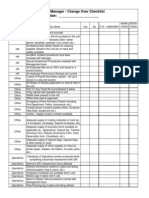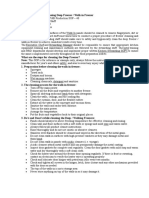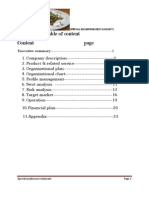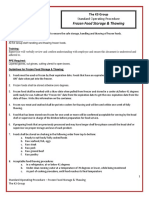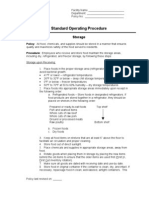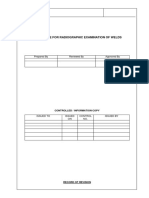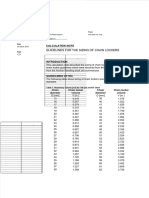SOP Storage
SOP Storage
Uploaded by
AnikBudianyCopyright:
Available Formats
SOP Storage
SOP Storage
Uploaded by
AnikBudianyOriginal Description:
Copyright
Available Formats
Share this document
Did you find this document useful?
Is this content inappropriate?
Copyright:
Available Formats
SOP Storage
SOP Storage
Uploaded by
AnikBudianyCopyright:
Available Formats
Standard Operating Procedures
Storage
Policy: All food, chemicals, and supplies should be stored in a manner that ensures
quality and maximizes safety of the food served to customers.
Procedure: Employees who receive and store food maintain the storage areas,
including dry, refrigerated, and freezer storage, by following these steps:
Storage Upon Receiving:
1. Place potentially hazardous foods in the proper storage area quickly to
avoid bacterial growth:
41F or lower refrigerator temperatures
26F to 32F deep chill storage temperatures
0F or below freezer temperatures
50F to 70F at 50% to 60% humidity dry storage temperatures
2. Place foods into appropriate storage areas immediately upon receipt in the
following order:
a. Refrigerated foods Store foods in designated refrigerators. If food
products are stored together in a refrigerator, they should be placed on
shelves in the following order:
Prepared or ready-to-eat foods (top shelf)
Fish and seafood items
Whole cuts of raw beef
Whole cuts of raw pork
Ground or processed meats
Raw poultry (bottom shelf)
b. Frozen food
c. Dry goods
3. Keep all food items on shelves at least 6 above the floor to facilitate air
circulation and proper cleaning.
4. Store food out of direct sunlight.
5. Place chemicals and supplies in appropriate storage areas, away from food.
6. Rotate goods when placing them in storage by placing the new items behind
the old items to ensure that the older items are used first (First In, First Out
inventory rotation).
7. Make sure all packages (i.e. each can in the case) are dated with receiving
date and use-by date.
8. Store food in original container if the container is clean, dry, and intact. If
necessary, repackage food in clean, well-labeled, airtight containers. This
also can be done after a package is opened. Food is NEVER put in
chemical containers and chemicals are NEVER placed in food storage
containers.
9. Store potentially hazardous foods no more than 7 days at 41F from date of
preparation.
10. Store pesticides and chemicals away from food handling and storage areas.
They must be stored in original, labeled containers.
Policy last revised on: _______
Standard Operating Procedures
Storage, continued
Storeroom sanitation:
1. Maintain clean and uncluttered storage areas. Storage areas should be
positioned to prevent contamination from garbage.
2. Dispose of items that are beyond the expiration or use by dates.
3. Store all items on shelves at least 6 above the floor to facilitate air
circulation and proper cleaning.
4. Check for signs of rodents or insects. If there are signs of the presence of
rodents or insects, notify the restaurant manager.
Temperature Control:
1. Check the temperature of all refrigerators, freezers, and dry storerooms at
the beginning of each day.
Refrigerator temperatures should be between 36F and 41F.
Freezer temperatures should be between -10F and 0F.
Storeroom (dry storage) temperatures should be between 50F and
70F.
2. Record temperatures on the appropriate temperature log and initial.
3. Take corrective actions if temperatures are out of the recommended range.
4. Dont overload refrigerated storage areas, as this prevents air flow and
makes the unit work harder to stay cold.
5. Use caution when cooling hot food in the refrigerator, as this warms the unit
and puts other foods into the temperature danger zone.
6. Keep units closed as much as possible to maintain proper temperatures.
7. Defrost all units on a regular schedule to aid in proper maintenance and air
circulation.
The restaurant manager will:
1. Check logs and temperatures of storage rooms, freezers, and refrigerators.
2. Review logs to make sure there are no temperature deviations.
3. Document all corrective action taken on the appropriate forms.
4. File logs with HACCP records.
Policy last revised on: _______
You might also like
- Weekly Kitchen Inspection ChecklistDocument2 pagesWeekly Kitchen Inspection Checklistabdul qudoos100% (6)
- Kitchen Station Task ListDocument9 pagesKitchen Station Task ListJefferson LimNo ratings yet
- FDNY Forcible Entry Reference Guide: Techniques and ProceduresDocument177 pagesFDNY Forcible Entry Reference Guide: Techniques and ProceduresLexipol_Media_Group100% (4)
- SOP - VegetableDocument9 pagesSOP - VegetableBoopathi ChinnaduraiNo ratings yet
- Daily Kitchen Checklist: Daily or After Each Use InitialsDocument1 pageDaily Kitchen Checklist: Daily or After Each Use InitialsAnonymous AEEGYnX100% (1)
- Handbook of Microbiological Criteria for FoodsFrom EverandHandbook of Microbiological Criteria for FoodsNo ratings yet
- Kitchen Inspection ChecklistDocument8 pagesKitchen Inspection ChecklisttzryadNo ratings yet
- !SOP CookingDocument1 page!SOP CookingShee Ying0% (1)
- Daily Audit ReportDocument3 pagesDaily Audit ReportJames Mathai100% (2)
- Audit Catering Check ListDocument3 pagesAudit Catering Check ListMuataz Alkhateeb100% (4)
- Stewarding SOP For Cleaning Deep FreezerDocument7 pagesStewarding SOP For Cleaning Deep FreezerMdrahaman Mithu100% (2)
- HACCP Plan Kitchen GuidelinesDocument8 pagesHACCP Plan Kitchen GuidelinesHACCPEuropa100% (13)
- Manager Changeover ChecklistDocument56 pagesManager Changeover Checklistmanishpandey1972No ratings yet
- GMP StatementDocument2 pagesGMP Statementkaransinghrai100% (1)
- F&B Outlet Spot CheckDocument2 pagesF&B Outlet Spot Checkzuldvsb100% (1)
- Avenues Clnic Annual Reports 2017Document56 pagesAvenues Clnic Annual Reports 2017kudakwashe manwaNo ratings yet
- SOP For Receiving of Food and Raw Materials in KitchenDocument2 pagesSOP For Receiving of Food and Raw Materials in KitchenAmgad saqr100% (5)
- Stewarding SOP For Cleaning Deep Freezer Walk-In FreezerDocument1 pageStewarding SOP For Cleaning Deep Freezer Walk-In FreezerAmgad saqrNo ratings yet
- HACCP ManualDocument24 pagesHACCP ManualSanchit kanwar100% (3)
- Sop Store Room SafetyDocument4 pagesSop Store Room SafetyamirNo ratings yet
- Form Incoming Goods FormDocument1 pageForm Incoming Goods FormfisherkiddNo ratings yet
- Food Contact Surfaces Cleaning and San It I Zing LogDocument1 pageFood Contact Surfaces Cleaning and San It I Zing LogBahiru BtNo ratings yet
- Food Safety ChecklistDocument4 pagesFood Safety Checklistjalali007No ratings yet
- Vegetable Sanitizing - Control SheetDocument2 pagesVegetable Sanitizing - Control Sheetsyed zia ul hassan100% (1)
- Standard Operating Procedures: Food PreparationDocument12 pagesStandard Operating Procedures: Food PreparationSheila Tuli50% (2)
- Food Safety Checklist: Personal HygieneDocument4 pagesFood Safety Checklist: Personal Hygienegulloque75% (4)
- Self Checklist For Food and Beverage Industry PDFDocument3 pagesSelf Checklist For Food and Beverage Industry PDFImee S. Yu100% (2)
- HACCP-Based SOP: Food Safety ChecklistDocument4 pagesHACCP-Based SOP: Food Safety ChecklistЕлена Коваленко100% (2)
- SOP Dealing With Food Allergies and Special Dietary Requirements PDFDocument2 pagesSOP Dealing With Food Allergies and Special Dietary Requirements PDFfiona daulimaNo ratings yet
- HACCP & Sanitation in Restaurants and Food Service Operations: A Practical Guide Based on the USDA Food CodeFrom EverandHACCP & Sanitation in Restaurants and Food Service Operations: A Practical Guide Based on the USDA Food CodeRating: 2 out of 5 stars2/5 (5)
- Table of Content Content PageDocument22 pagesTable of Content Content PageTewodros G LeNo ratings yet
- SOP StorageDocument3 pagesSOP StorageJessNo ratings yet
- Sop - Kitchen DepartmentDocument11 pagesSop - Kitchen DepartmentChef Chef100% (4)
- Week 5 Risk MGTDocument10 pagesWeek 5 Risk MGTjudezaNo ratings yet
- Standard Receiving ProceduresDocument2 pagesStandard Receiving ProceduresKimmy Biaco100% (1)
- Sanitation Procedures and PracticesDocument14 pagesSanitation Procedures and PracticesButters AJNo ratings yet
- The Food Production FlowDocument120 pagesThe Food Production FlowTrisha Racho100% (1)
- Thawing FoodDocument2 pagesThawing FoodAddress Hotel100% (1)
- Purchasing, Receiving, Handling and Storage of Meat GuidlinesDocument16 pagesPurchasing, Receiving, Handling and Storage of Meat Guidlinesthei riosNo ratings yet
- SOP Cleaning and Sanitizing - 2!15!16Document3 pagesSOP Cleaning and Sanitizing - 2!15!16Kenneth Paul OlinanNo ratings yet
- Restaurants Checklist V3Document7 pagesRestaurants Checklist V3AzharNo ratings yet
- Sunnyside HACCP Plan 2012V1.2Document42 pagesSunnyside HACCP Plan 2012V1.2fisherkiddNo ratings yet
- SOP Receiving-DeliveriesDocument2 pagesSOP Receiving-DeliveriesErdinan Setiawan100% (1)
- KITCHENDocument5 pagesKITCHENgilbertmalcolmNo ratings yet
- Kitchen Equipment Handling and Maintaining Standard Procedure and PoliciesDocument2 pagesKitchen Equipment Handling and Maintaining Standard Procedure and PoliciesChef Chef86% (7)
- SOP Facility and Equipment HygieneDocument6 pagesSOP Facility and Equipment HygieneHenry Taguma100% (2)
- SOPs For Food Business OperatorsDocument29 pagesSOPs For Food Business OperatorsWaqarAhmedButtNo ratings yet
- Form # SOP-10-9 Chiller Temperature RecordDocument1 pageForm # SOP-10-9 Chiller Temperature Recordnadim haque0% (1)
- 4+K3+SOP+Frozen+Food+Storage+&+Thawing+Procedure PDF+Document2 pages4+K3+SOP+Frozen+Food+Storage+&+Thawing+Procedure PDF+AbhishekNo ratings yet
- Food Safety and Cleanliness Checklist FormDocument2 pagesFood Safety and Cleanliness Checklist Formzoltan2014No ratings yet
- Cleaning and Sanitizing Food Contact SurfacesDocument4 pagesCleaning and Sanitizing Food Contact SurfacesAnna Liza R. Mercado100% (1)
- Kitchen Stewarding - Facility PlanningDocument20 pagesKitchen Stewarding - Facility Planninglaksh100% (3)
- Kitchen Equipment Handling and Maintaining Standard Procedure and PoliciesDocument3 pagesKitchen Equipment Handling and Maintaining Standard Procedure and PoliciesManas Raodaskar100% (1)
- Washing Fruits and VegetablesDocument2 pagesWashing Fruits and VegetablesSaravana Kumar100% (1)
- Sanitation & Food Safety Standard Operating Procedure ManualDocument15 pagesSanitation & Food Safety Standard Operating Procedure ManualPong CanosaNo ratings yet
- Daily Cleaning Checklist - Night - MKDocument4 pagesDaily Cleaning Checklist - Night - MKMohamed Mohzin Ghouse100% (2)
- SOP For Food ProductionDocument3 pagesSOP For Food ProductionANGELOU SAGARAL50% (2)
- Kitchen Opening Check Sheet: Week Beginning: SiteDocument4 pagesKitchen Opening Check Sheet: Week Beginning: SiteGautam Bhalla100% (2)
- Storing Food SopDocument2 pagesStoring Food SopoveroricaNo ratings yet
- Tandard Perating Rocedure: StorageDocument2 pagesTandard Perating Rocedure: StorageJessa Mae AlgarmeNo ratings yet
- SOP StorageDocument3 pagesSOP Storagedickson86100% (3)
- Standard Operating Procedure: StorageDocument2 pagesStandard Operating Procedure: Storagesunny mgx100% (1)
- The Advantages and Disadvantages of Using HVDC To Interconnect AC NetworksDocument5 pagesThe Advantages and Disadvantages of Using HVDC To Interconnect AC NetworksNidhiNo ratings yet
- I Fought For My Life-1Document2 pagesI Fought For My Life-1Akarsh GuptaNo ratings yet
- Do You Think That There Is A Strong Relationship Among Healt1Document3 pagesDo You Think That There Is A Strong Relationship Among Healt1CarlNo ratings yet
- Selected Works in Contemporary TimesDocument46 pagesSelected Works in Contemporary TimesAcey Acey AceyNo ratings yet
- Vastu Homam ChecklistDocument2 pagesVastu Homam ChecklistManohar LuckyNo ratings yet
- Wisconsin Comprehensive School Counseling Standards and BenchmarksDocument10 pagesWisconsin Comprehensive School Counseling Standards and Benchmarksapi-299509982No ratings yet
- St. Stephen's Hospital Rate ListDocument41 pagesSt. Stephen's Hospital Rate ListNeyaz HasnainNo ratings yet
- Automotive Bulb Application GuideDocument36 pagesAutomotive Bulb Application GuideChris AdsheadNo ratings yet
- PDF Katalog Noggerath Hrs 95d713Document2 pagesPDF Katalog Noggerath Hrs 95d713eng.mfathi0No ratings yet
- Hans Gerding: Philosophical Counseling As Part of Clinical ParapsychologyDocument2 pagesHans Gerding: Philosophical Counseling As Part of Clinical ParapsychologyRico SnellerNo ratings yet
- Postive DisciplineDocument5 pagesPostive DisciplineWanda KuneneNo ratings yet
- Cellular Microbiology - 2016 - Pereira Silva - Genome Wide Transcriptome Analysis of Aspergillus Fumigatus Exposed ToDocument21 pagesCellular Microbiology - 2016 - Pereira Silva - Genome Wide Transcriptome Analysis of Aspergillus Fumigatus Exposed ToEllie SmithNo ratings yet
- 2018 Alfa Romeo Giulia Quadrifoglio OM 2ndDocument260 pages2018 Alfa Romeo Giulia Quadrifoglio OM 2ndlinein_lineoutNo ratings yet
- HLTH 1020 Dietary Analysis Final AssignmentDocument11 pagesHLTH 1020 Dietary Analysis Final Assignmentapi-438184229No ratings yet
- Exploris Spare PartsDocument56 pagesExploris Spare PartsmaxnecrochemistNo ratings yet
- RT Procedures For WeldDocument19 pagesRT Procedures For WeldABHIJIT GIRINo ratings yet
- Catalytic Esterification of Bio-Oil by Ion Exchange Resins (WANG Jin-Jiang, CHANG Jie, FAN Juan)Document5 pagesCatalytic Esterification of Bio-Oil by Ion Exchange Resins (WANG Jin-Jiang, CHANG Jie, FAN Juan)HappyNo ratings yet
- Dura-Blue: PVC Municipal Water Distribution Pipe (4 - 12")Document3 pagesDura-Blue: PVC Municipal Water Distribution Pipe (4 - 12")buddhika MadusankaNo ratings yet
- Fundamentals of Hypnotherapy ModalitiesDocument217 pagesFundamentals of Hypnotherapy ModalitiesAnandh .r100% (1)
- Third Eye IEEE FORMATDocument2 pagesThird Eye IEEE FORMATshanthannarenNo ratings yet
- The Impact of Active and Passive Smoking Upon Health and Neurocognitive Function.Document4 pagesThe Impact of Active and Passive Smoking Upon Health and Neurocognitive Function.AmiraNo ratings yet
- KS CD Anh 10 - KS CD Anh 10 - Lan 2 - 263Document5 pagesKS CD Anh 10 - KS CD Anh 10 - Lan 2 - 263thihuongedufutureNo ratings yet
- Full Download Sterile Pharmaceutical Products Process Engineering Applications First Edition Avis PDFDocument59 pagesFull Download Sterile Pharmaceutical Products Process Engineering Applications First Edition Avis PDFtwinkkalraek100% (3)
- Guidelines For The Sizing of Chain Lockers RevaDocument9 pagesGuidelines For The Sizing of Chain Lockers Revafle92No ratings yet
- Cedarbrook StoriesDocument43 pagesCedarbrook StoriesF. Remy DiederichNo ratings yet
- Phraser Connector, Issue 58, May 2017Document12 pagesPhraser Connector, Issue 58, May 2017Anthony StarkNo ratings yet
- 2021 Police Benevolent Asso V Police Benevolent Asso PETITION 1Document37 pages2021 Police Benevolent Asso V Police Benevolent Asso PETITION 1Matt TroutmanNo ratings yet












